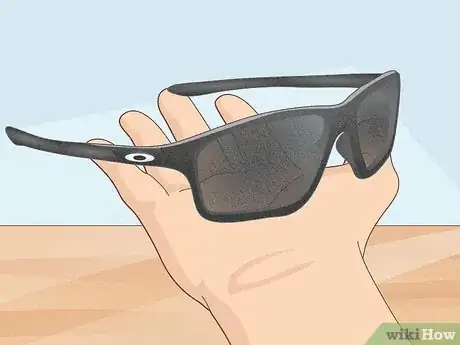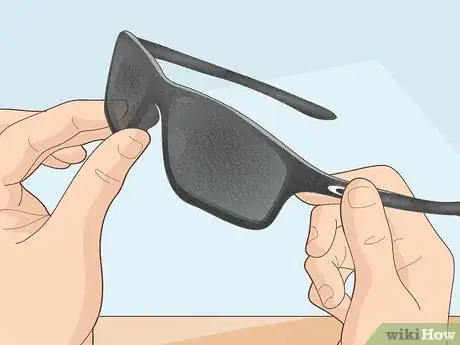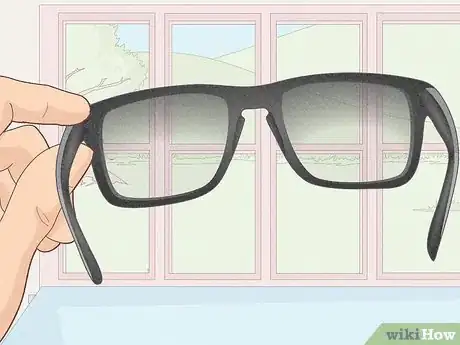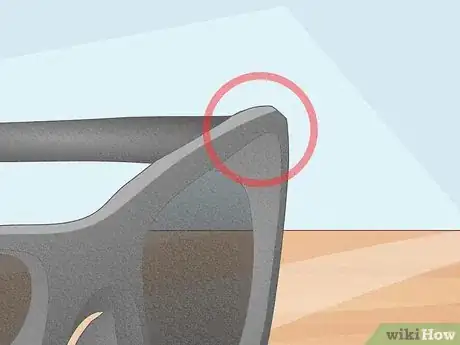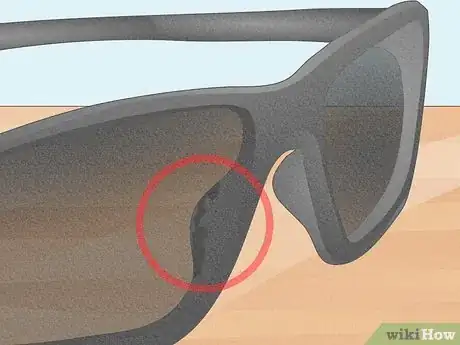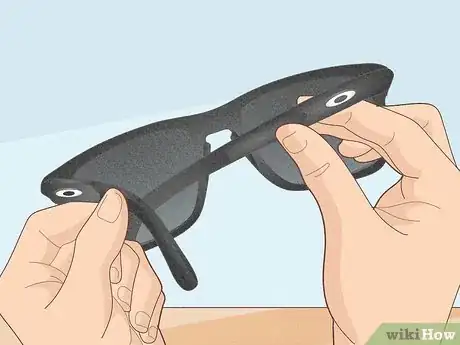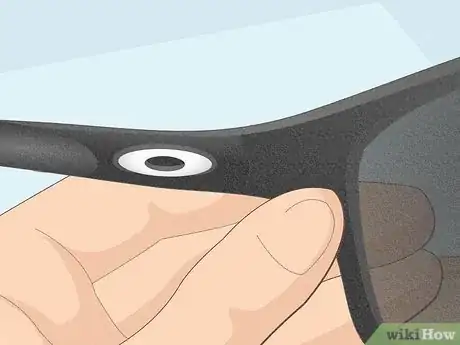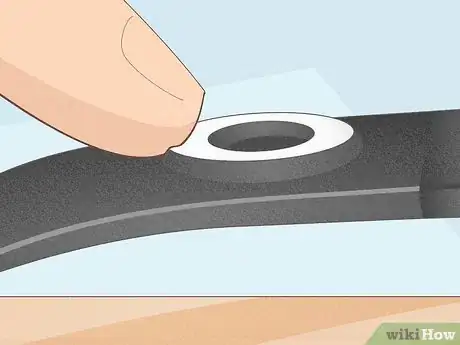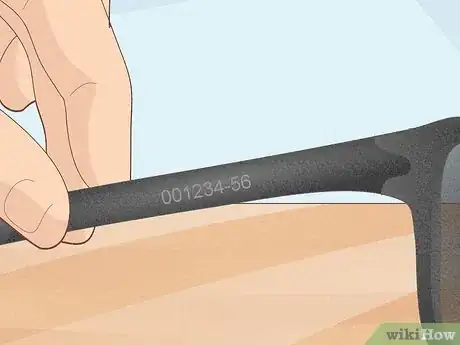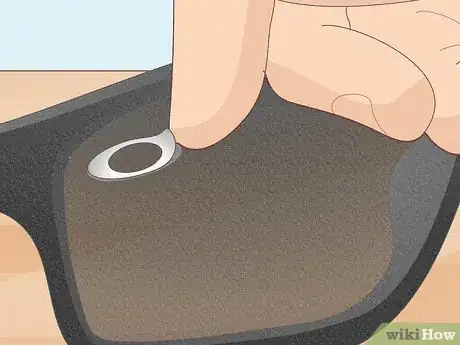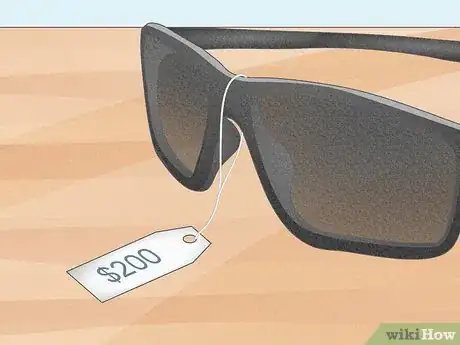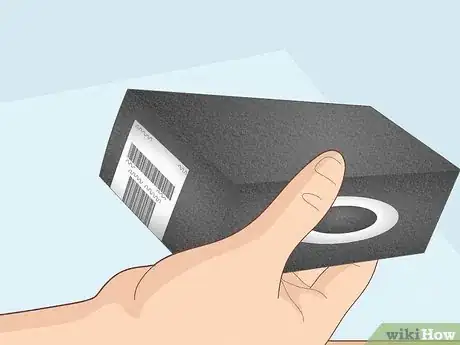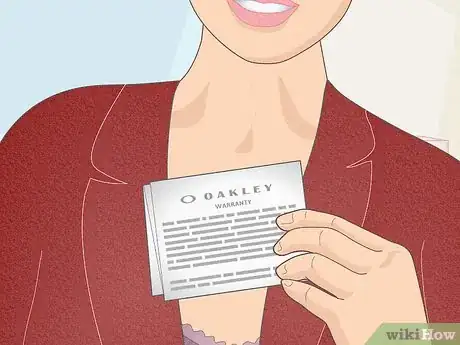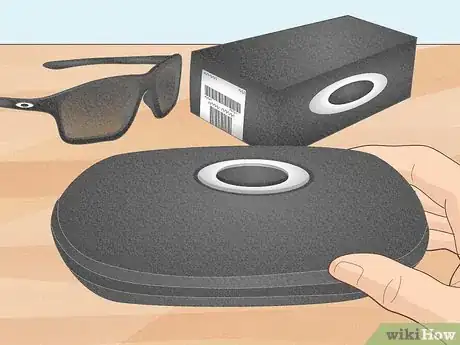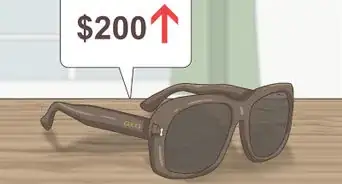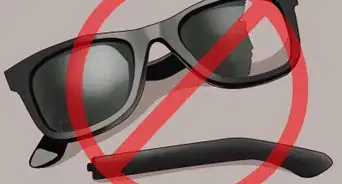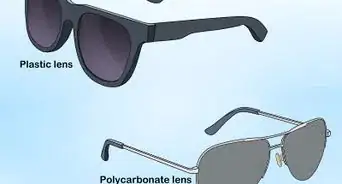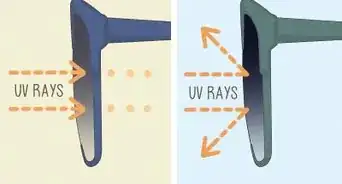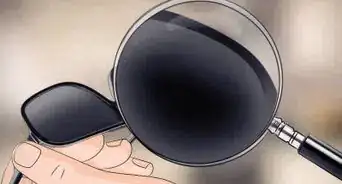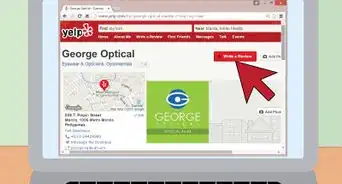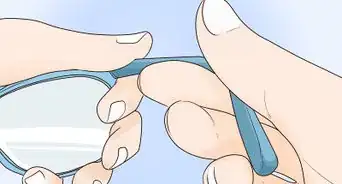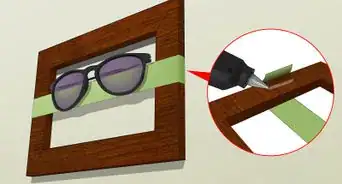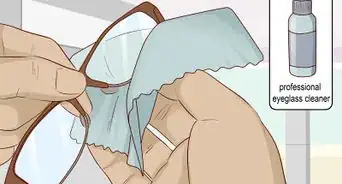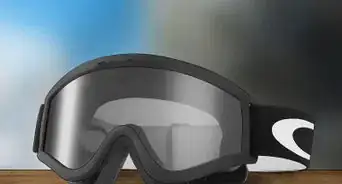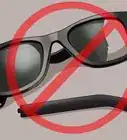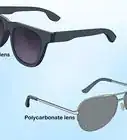This article was co-authored by wikiHow Staff. Our trained team of editors and researchers validate articles for accuracy and comprehensiveness. wikiHow's Content Management Team carefully monitors the work from our editorial staff to ensure that each article is backed by trusted research and meets our high quality standards.
There are 17 references cited in this article, which can be found at the bottom of the page.
This article has been viewed 118,887 times.
Learn more...
Due to their popularity, price, and patented sun-blocking technology, Oakley sunglasses are one of the most widely counterfeited designer accessories on the market. As a consumer, it’s not always easy to tell a real pair of Oakleys from an inferior knockoff. Fortunately, the company’s product design, branding elements, and accessories include a number of features that can help you determine whether or not the pair you’re looking at are the genuine article.
Steps
Evaluating the Craftsmanship
-
1Perform a quick visual assessment of the product’s quality. In most cases, all it will take to tell if you’re dealing with a cheap imitation is a glance. Genuine Oakley sunglasses are assembled from premium hard-wearing plastics, metals, and rubbers. Knockoffs, on the other hand, are often hastily thrown together using the least expensive materials available—and it shows.[1]
- Take as much time as you need to conduct your inspection. If the vendor tries to distract you, hurry you along, or discouraging you from handling their merchandise, they may have something to hide.
Tip: Use your common sense and trust your gut. When you’re faced with the real thing, you’ll know it.
-
2Hold the glasses to get a sense of how they’re constructed. Oakleys are renowned for their solid construction and durability. Because of these, real ones will have a bit of heft to them. Be sure to also feel for issues like flimsy hinges or loose lenses. Flaws like these are serious red flags.[2]
- Bogus Oakleys may also be noticeably smaller than their authentic counterparts. This happens when the makers attempt to cut down on the cost of production by using less material.[3]
Advertisement -
3Gauge the quality and clarity of the lenses. Oakleys are designed for performance. This means that the lenses on real sunglasses will be crystal clear and perfectly tinted to block out the sun while ensuring optimal visibility. By contrast, the lenses on fakes may be cloudy or hard to see through. You may even notice peeling around the edges, evidence that they’ve been tinted with a cheap film.[4]
- Many Oakley models boast scratch-resistant lenses. A little light scratching may be an indication of age, but if the lenses are criss-crossed with large gouges, it’s probably because they’re made from inferior quality materials.[5]
- Even pre-owned pairs will retain their clarity and tint integrity after years of regular use.
-
4Look for obvious raised seams on the frames. Actual Oakley frames are all smooth contours and neatly-molded square edges. A bad molding job is another tell-tale sign that someone is trying to swindle you out of your hard-earned money. Fortunately, it’s also one that’s hard to miss.[6]
- The worst offenders might even be pieced together from multiple pieces that aren’t perfectly aligned.
-
5Keep an eye out for areas where the color is chipping or flaking. Unlike real Oakleys, which are molded from pre-dyed plastics, “Foakleys” are typically colored with a single coat of cheap paint. If you notice any spots where the finish is coming off and there’s another color visible beneath, you can be certain that they’re not the real McCoy.[7]
- This rule may not apply to sunglasses that are made from metal or painted with a special finish. However, you can still judge the quality of the paint job by examining the edge of each arm where it folds into the eyepiece.[8]
- As tempting as it may be to scratch the sunglasses yourself, don't. Most vendors will expect you to pay for items that you’ve damaged, and the last thing you want is to get stuck with a pair of shades after determining that they’re phony.
-
6Open and close the arms to see how well the hinges work. The movement of the arms should be buttery smooth through their entire range of motion, thanks to Oakley’s sturdy full plastic hinges. The cheap metal hinges commonly used to manufacture fugazi sunglasses, including Foakleys, have a much higher likelihood of sticking, coming loose, or even breaking after a few wears.[9]
- Select Oakley hinges may contain metal components, but these will be slender pins, not large, clunky screws.[10]
-
7Try the glasses on to test them for comfort. The rubber on real Oakleys is soft and slightly spongy, which makes for a cozy, all-day fit. It should almost feel like you’re not wearing glasses at all. Hard, rough, or ill-fitting ear socks and nose pieces are a clear indicator that someone’s trying to pull a fast one.[11]
- The removable ear socks on fake glasses may not want to stay in place while you’re wearing them, or be suspiciously easy to slip on and off when you’re not.[12]
-
8Have someone else look them over. Advances in technology and manufacturing have made it easier than ever to pass off convincing forgeries. If you’ve looked a particular pair of sunglasses over from top to bottom and still aren’t sure whether they’re real, it may help to get a second set of eyes on them. Someone who’s had experience with Oakley products in the past will be especially trustworthy.[13]
- Designer brand forums and online communities centered around Oakley products can be great places to go for a second opinion.[14]
- When in doubt, it’s always best to get your Oakley sunglasses and accessories from an official Oakley outlet store, or a licensed dealer like Sunglass Hut.
Identifying Signature Branding Elements
-
1Look for the trademark Oakley logo on the outer part of the frames. All Oakley sunglasses display the company’s signature “O” logo. In most cases, you’ll find it on the temple section of one or both arms. If the glasses don’t feature a logo at all, leave them on the shelf. This is a dead giveaway that they’re a con job.[15]
- Certain newer models, like the popular Frogskins, bear the full name of the brand in place of the smaller symbol. This script will be written in the recognizable Oakley font and have a clean, precise, polished look.
- The Oakley “O” has undergone a few re-imaginings over the years. Don’t be too quick to cry foul if the logo isn’t identical to the one found on other pairs. It could just be that you’ve got a slightly newer or older model on your hands.
Tip: Compare the placement of the logo on the pair you’re looking at to stock photos of the same model on the Internet. If it’s in a different area, it means that the counterfeiter got sloppy.
-
2Note whether the logo is three-dimensional or flat. Once you’ve pinpointed the brand’s logo, take stock of its general appearance. On bona fide Oakley sunglasses, the “O” will always be embossed rather than stamped or painted. Additionally, it will most often be made of metal, and be clearly distinguishable from the plastic used for the frames.[16]
- The logo may be plastic on some pairs, but the quality and detail of the molding will still be the same.
-
3Check for a 5- or 8-digit item number on the inside of the left arm. Before a pair of Oakleys leaves the factory, it’s printed with an SKU, or “stock keeping unit” item number. On older pairs, the SKU will appear as a 5-digit hyphenated number, such as “12-345.” Newer pairs are marked with an 8-digit hyphenated number that begins with “00,” as in “001234-56.”[17]
- More elaborate fakes are sometimes printed with randomized SKUs. However, these don’t always match the model of the glasses they’re printed on. If the model you’re appraising have an item number on them, take a moment to punch it into a search engine to confirm whether it’s legit.
- Some Oakley sunglasses are still made in the U.S., but many are manufactured elsewhere these days. Seeing “Made in China” written on the arm shouldn’t necessarily set off any alarm bells.[18]
-
4Be wary of cheap or branded stickers on the lenses. The majority of Oakley sunglasses don’t have stickers on them, whether on the lenses or anywhere else. When they are present, they’ll always be the soft, flexible cling type, not the sticky variety. If you peel off a sticker and it leaves behind a layer of adhesive residue, you’ve been taken for a ride.[19]
- Oakley only puts stickers on the lenses of their polarized glasses, and these are only printed with the letter “P,” never the company name or logo.[20]
- As a general rule of thumb, if you see a sticker on a pair of Oakley shades, there’s a good chance that they’re impostors.
Examining the Included Accessories and Other Features
-
1Check the price tag. As the old cliché goes, if looks too good to be true, it probably is. You can generally expect to pay at least $80-100 dollars for even a lightly-used pair of Oakleys. Factory-fresh sunglasses will likely run you closer to $150-200, or sometimes more.[21]
- Lots of factors can contribute to an item’s price, including age, wear, the number of original accessories included, and the amount the seller paid for it. Keep this in mind when trying to determine whether the sunglasses look like they’re worth the number on the price tag.
Tip: If you’re buying online, run a quick search for the model you’re after to get a sense of its average retail value and compare it to other listings in similar condition.
-
2Size up the retail box when buying new sunglasses. Scan the box to verify that all logos, images, fonts, and special branding terms are presented the same way that they are on the company’s official website. Included in the info you find there will be the product’s model name, SKU, and item description, along with a unique barcode. Verify that each of these details correspond to the characteristics of the model you’re shopping for.[22]
- Take a moment to give the packaging itself a good hard look, too. If there’s anything fishy about the box design, like bleeding ink, off-kilter printing, or misspelled text, consider it a heads up.
-
3Ask if they come with a certificate of authenticity or warranty card. You’ll receive both these pieces of paperwork anytime you purchase a brand new pair of Oakley sunglasses. Certifying documents like these are intended specifically to assure buyers that what they’re getting is the real deal. Be wary of glasses being advertised as new or unworn that don’t come with them.[23]
- If you’re buying previously-owned, the seller may or may not still have the original certificate and warranty card in their possession. In this case, you’ll need to rely on other methods of authentication.
-
4Look over the case or pouch that the sunglasses come in. Unless you’re getting your Oakleys secondhand, they should come safely stored in a protective hard case or soft microfiber pouch. This container itself can provide a clue as to the product’s origin. If it’s cheaply-made or emblazoned with a suspect-looking logo, you may want to reconsider your purchase.[24]
- Models that are sold in hard cases will also generally come with a cleaning cloth, which will be printed with the Oakley name or logo, as well.
- Make sure you pay just as much attention to what’s inside. It’s not uncommon for scam artists to repackage fake sunglasses in original designer cases.
Warnings
- When you shop for sunglasses online, or anywhere other than a licensed Oakley dealer, you do so at your own risk. It’s much easier to pass off phony goods over the Internet.⧼thumbs_response⧽
- Fake sunglasses aren’t subjected to the rigorous UV-protection tests mandated by the FDA. Because of this, there’s a chance that wearing them in bright conditions for prolonged periods of time could result in temporary visual impairment or more serious eye damage.[26]⧼thumbs_response⧽
References
- ↑ https://www.oakleyforum.com/guides/how-to-spot-fake-oakleys-sunglasses/
- ↑ https://eyerim.com/blog/how-to-spot-authentic-oakley-sunglasses
- ↑ https://www.oakleyforum.com/guides/how-to-spot-fake-oakleys-sunglasses/
- ↑ https://www.eyecarecs.com/how-to-spot-counterfeit-oakley-designer-frames/
- ↑ https://www.oakley.com/en-us/support/product-care
- ↑ https://www.youtube.com/watch?v=2dcBYCUFSOQ&feature=youtu.be&t=511
- ↑ https://www.oakleyforum.com/threads/how-to-spot-fake-oakleys-guide.88846/page-3
- ↑ https://www.youtube.com/watch?v=JxQUpoh65bw&feature=youtu.be&t=62
- ↑ https://www.tetongravity.com/story/Lifestyle/buy-face-oakley-sunglasses-with-full-confidence#!
- ↑ https://staminist.com/read.php?1,537
- ↑ https://www.lentiamo.co.uk/blog/ways-to-tell-sunglasses-are-fake.html
- ↑ https://www.oakleyforum.com/guides/how-to-spot-fake-oakleys-sunglasses/
- ↑ https://www.tetongravity.com/story/lifestyle/how-to-spot-fake-oakleys
- ↑ https://www.oakleyforum.com/guides/how-to-spot-fake-oakleys-sunglasses/
- ↑ https://www.eyecarecs.com/how-to-spot-counterfeit-oakley-designer-frames/
- ↑ https://www.youtube.com/watch?v=B7j6V8KSmP0&feature=youtu.be&t=15
- ↑ https://www.oakleyforum.com/guides/how-to-spot-fake-oakleys-sunglasses/
- ↑ https://www.oakley.com/en-us/support/faq
- ↑ https://www.youtube.com/watch?v=B7j6V8KSmP0&feature=youtu.be&t=23
- ↑ https://eyerim.com/blog/how-to-spot-authentic-oakley-sunglasses
- ↑ https://www.youtube.com/watch?v=JxQUpoh65bw&feature=youtu.be&t=20
- ↑ https://www.youtube.com/watch?v=2dcBYCUFSOQ&feature=youtu.be&t=113
- ↑ https://eyerim.com/blog/how-to-spot-authentic-oakley-sunglasses
- ↑ https://eyerim.com/blog/how-to-spot-authentic-oakley-sunglasses
- ↑ https://www.oakley.com/en-us/support/faq
- ↑ https://www.aao.org/eye-health/diseases/photokeratitis-snow-blindness
About This Article
Due to their popularity and price, fake Oakley sunglasses are quite common, but there are some easy ways to tell them apart from genuine ones. Real Oakley glasses will be made of quality materials, the hinges will feel sturdy, and the lenses will be clear, while fakes will often be flimsy with cloudy lenses. Genuine glasses will also come with a protective case or pouch. Look for the letter O logo, which is generally found on the temple of one or both arms. Some newer models have the brand name printed instead. Real glasses will also have a 5- or 8-digit item number on the inside of the left arm. Don’t expect to pay less than 80 dollars for a used pair or 150 for a new pair of Oakley sunglasses. For more tips, including how to spot a fake pair of Oakley sunglasses online, read on!
